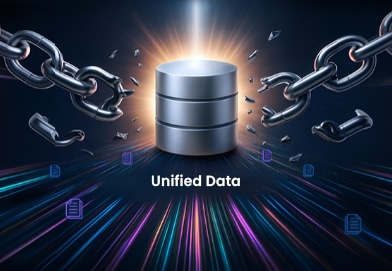Data privacy is crucial for databases as digital systems touch every corner of our lives. With the explosion of data and increased reliance on databases, concerns about protecting sensitive information are more pressing than ever. Both individuals and business operations are vulnerable to the severe consequences of data breaches and privacy violations.
Database administration, encompassing data management, data storage, and data collection, implements robust security measures to protect against unauthorized access and breaches. It ensures compliance with data protection laws like HIPAA, GDPR, and CCPA. In this blog, we’ll explore top data privacy best practices for securing customer data and empowering organizations to foster a secure digital environment.

What Are Data Privacy Best Practices in Database Administration?
Data security is paramount in today’s digital landscape, and Ekran System offers a comprehensive, top-notch data protection solution. These data privacy best practices include robust user activity monitoring, real-time alerting, and behavior analysis to detect and mitigate potential threats.
Ekran System also prioritizes insider threat and data loss prevention through session recording and user behavior analytics, allowing organizations to identify and address suspicious activities. It also provides powerful encryption, access control, and audit trail capabilities to safeguard sensitive data.
Safeguarding Sensitive Data
Safeguarding sensitive data is crucial. Understanding what is sensitive data and how to protect it is essential. Encryption, access controls, and strong authentication are key. Regularly updating systems and training employees are critical. Defined security policies and procedures supported by incident response plans are vital to address breaches. Combining technology, education, and a culture of data security upholds the commitment to protect data and maintain trust.
How to Prevent Data Breaches
Preventing data breaches is critical for organizations of all sizes and industries. First and foremost, robust cybersecurity measures should be in place, including firewalls, intrusion detection systems, and regular software patching to address vulnerabilities. Security awareness training and programs are crucial, as human error is a common factor in breaches. Strong, unique passwords and multi-factor authentication should be enforced across all accounts and systems.
Data encryption, both at rest and in transit, adds an extra layer of protection, making it harder for unauthorized users and parties to access sensitive and personal information. Regular security audits and vulnerability assessments can help identify potential weaknesses proactively. Lastly, implementing a comprehensive incident response plan is essential for swift action in case of a breach, minimizing its impact, and ensuring legal and regulatory compliance.
What Is Access Control?
Access control is a fundamental aspect of data privacy in database administration. It establishes mechanisms to control and manage user access to databases, ensuring only authorized individuals can view or manipulate sensitive information. Implementing robust access controls prevents unauthorized access to confidential data, reduces breaches, and maintains privacy.
Role-Based Access Control (RBAC)
Role-Based Access Control (RBAC) is a widely adopted access control model that assigns user privileges based on predefined roles. Instead of granting permissions to access data directly to individual users, access privileges are assigned to roles, and users are assigned to only those privileges or roles based on their job responsibilities. This approach ensures that users only have the necessary privileges to perform their tasks, minimizing the risk of accidental or intentional data exposure.

DBAs should design and implement RBAC policies that align with the organization’s data privacy requirements. Roles should be defined based on job functions, and access privileges should be granted accordingly. Regular review and updates of RBAC policies are crucial to ensure access privileges remain appropriate as job roles change within the organization.
Principle of Least Privilege (PoLP)
The Principle of Least Privilege (PoLP) is a security principle that advocates granting users the minimum access privileges necessary to perform their assigned tasks. DBAs should adopt this principle when defining access controls for databases to limit the potential damage caused by a compromised user account or unauthorized access.
By applying the PoLP, DBAs should regularly review and audit user access privileges. Users should only be granted access to the specific data and functionalities required for their job functions. Any unnecessary or excessive privileges for privileged users should be revoked promptly to minimize the risk of data breaches and privacy violations.
Strong Password Policies and Multi-Factor Authentication (MFA)
Weak passwords are a common vulnerability that can lead to unauthorized access. DBAs should enforce strong password management policies against cyber attacks and ensure robust passwords protect user accounts. Password policies should require a combination of uppercase and lowercase letters, numbers, and special characters and encourage regular password changes.
Additionally, implementing Multi-Factor Authentication (MFA) adds an extra layer of security. MFA requires users to provide additional verification factors, such as a one-time password sent to a mobile device, in addition to their password. This authentication method significantly reduces the risk of unauthorized access to private data, even if the password is compromised.
Encryption Techniques
Encrypting sensitive data is a crucial practice for protecting data privacy in database administration and cloud storage services. Encryption transforms data into an unreadable format, making it inaccessible to unauthorized individuals or malicious software. Even if an attacker gains access to the encrypted data, they cannot decipher it without the encryption key.
Virtual Private Network (VPN)
A Virtual Private Network (VPN) is a powerful tool that enhances online security and privacy while providing a secure connection between a user’s device and the internet. Encrypting data traffic and routing it through remote servers in various geographic locations, a VPN masks the user’s IP address and location, making it significantly harder for third parties, such as hackers or advertisers, to track and monitor their online activities.
VPNs are widely used by individuals and organizations alike to protect sensitive information, access geo-restricted content, and maintain anonymity on the internet. Whether safeguarding personal data on public Wi-Fi networks or enabling remote employees to access company resources securely, VPNs have become a fundamental component of modern digital privacy and cybersecurity strategies.
Transparent Data Encryption (TDE)
Transparent Data Encryption (TDE) is a technique that encrypts the entire database, including data files, log files, and data backups. TDE operates at the storage level, encrypting data as written to disk and decrypting it when read from disk. This method provides strong protection for data at rest, mitigating the risk of unauthorized access to data stored on physical storage media.

DBAs should enable TDE for sensitive databases to ensure that data remains encrypted, both in the database files and during backups. It is important to securely manage and protect the encryption keys to prevent unauthorized data decryption.
Secure Socket Layer (SSL) or Transport Layer Security (TLS)
In addition to data at rest, privacy must be ensured when data is in transit between the database server and client applications. Secure Socket Layer (SSL) and its successor Transport Layer Security (TLS) are encryption standards and protocols that provide secure communication channels.
DBAs should configure database servers to support SSL/TLS connections and enforce encrypted communication. SSL/TLS encryption prevents attackers from intercepting and reading sensitive data during transmission, making it significantly more challenging for them to gain unauthorized access. They should obtain SSL/TLS certificates from trusted certificate authorities and configure the database server to use them for secure connections. It is essential to regularly update the certificates to ensure the use of up-to-date cryptographic algorithms and protect against known vulnerabilities.
Furthermore, DBAs should enforce the use of encrypted connections by client applications. This can be achieved by configuring the database server to require SSL/TLS connections and rejecting unencrypted connections. Organizations can safeguard sensitive data by employing SSL/TLS encryption as it travels between the database and client applications. Speak with a pro here at Data Sleek to know more.
Auditing and Monitoring Practices
Regular auditing and monitoring are essential components of a robust data privacy strategy. By implementing comprehensive auditing and monitoring practices, DBAs can identify and address security incidents, detect unusual activities, and ensure database administrator security.
Database Auditing
Database auditing involves capturing and analyzing database activities to identify security breaches or policy violations. DBAs should configure auditing mechanisms to log all critical data events, such as user logins, privilege changes, data modifications, and access attempts. These data audit logs serve as valuable forensic evidence in the event of a security incident and help identify potential vulnerabilities or unauthorized activities.
It is important to define clear audit policies and retention periods for audit logs. Regular review and analysis of audit logs can provide insights into suspicious activities and enable timely response to security incidents.
Real-Time Monitoring
Real-time monitoring allows DBAs to actively track database activities and detect potential security threats or anomalies as they occur. DBAs can gain visibility into database operations, user activities, and system performance by utilizing monitoring tools and technologies.
Real-time monitoring can include monitoring database connections, tracking failed login attempts, identifying excessive privileges or unusual data access patterns, and monitoring system resources for any signs of compromise or abnormal behavior.

DBAs should configure monitoring alerts and notifications to identify and respond to potential security incidents promptly. These alerts can be configured to notify administrators of any suspicious activities, unauthorized access attempts, or database performance issues.
Timely Patching and Maintenance
Keeping database systems updated with the latest security patches is vital for maintaining data privacy. Regularly applying patches and updates to database software helps mitigate vulnerabilities that attackers could exploit. DBAs should follow these practices:
Vendor Updates and Security Advisories
Stay informed about security advisories and updates released by the database vendor. Promptly apply critical patches to address known vulnerabilities. Regularly monitor vendor websites, mailing lists, and security bulletins to stay updated with the latest security information.
Patch Management Process
Establish a structured patch management process that includes testing patches in non-production environments before applying them to production systems. This helps minimize the risk of unintended consequences. Consider utilizing a patch management system or automated tools to streamline the patching process and ensure timely updates.
Database Health Checks
Perform regular health checks to identify configuration issues, performance bottlenecks, or security vulnerabilities. These checks can help maintain a healthy and secure database environment. Monitor system logs, review system performance metrics, and conduct periodic vulnerability assessments to identify and address potential security risks proactively.
Data Retention and Disposal
Effective management of data retention and disposal is essential for data privacy. Retaining data longer than necessary increases the risk and cost of a data breach and compromises privacy. DBAs should adhere to the following guidelines:
Data Retention Policies
Develop and enforce data retention policies that specify the duration for which data should be stored. Periodically review the data usage policy and update these policies to align with changing regulatory requirements. Data retention policies should consider legal, regulatory, and business requirements, ensuring that data is retained for only as long as necessary.
Secure Data Disposal
Implement secure data disposal practices when data is no longer required. Ensure that sensitive information, like financial information, is permanently and securely deleted from the private network or database. This can be achieved through data shredding, overwriting, or specialized data disposal tools.
DBAs should also consider the disposal of physical storage media, such as hard drives or tapes, which may contain sensitive data. Proper disposal methods, such as degaussing or physical destruction, should be employed to prevent stolen data from being recovered.
It is essential to document, perform data discovery, and maintain records of data disposal activities to demonstrate compliance with data privacy regulations and provide an audit trail of data handling practices.
Data Masking and Anonymization
In addition to encryption, data masking and anonymization techniques play a crucial role in data privacy. DBAs can employ these methods to protect sensitive information while allowing developers and testers to work with realistic data in non-production environments. This involves replacing accurate data with fictitious but representative data, ensuring that the sensitive information remains concealed.
Organizations can significantly reduce the risk of exposure during development, testing, or analytics activities by implementing masking techniques. DBAs should carefully evaluate the sensitivity of the data and determine the appropriate level of masking required to protect privacy while maintaining integrity.

Data anonymization goes further by removing or modifying any identifying information from the dataset, making it impossible to associate the data with specific individuals. This technique is often used in research or analytics scenarios where privacy is paramount.
DBAs should collaborate with data owners, data scientists, and privacy experts to define and implement effective data masking and anonymization strategies. These strategies should align with the organization’s data privacy policies and comply with relevant regulations.
Employee Training and Awareness
While implementing technical measures is crucial, fostering a culture of data privacy among employees is equally important. DBAs should actively engage in security training programs and awareness campaigns to educate personnel about the significance of data privacy and their role in maintaining it.

Employees should be trained on data privacy best practices, data handling, password security, and recognizing potential security threats such as phishing attacks or social engineering tactics. Organizations can create a stronger defense against data theft, breaches, and privacy violations by raising awareness about data privacy and instilling a sense of responsibility among employees.
DBAs should collaborate with human resources and information security teams to develop comprehensive training programs. These programs should be tailored to employees’ specific roles and responsibilities, ensuring they understand their obligations to safeguard data privacy.
Regularly reinforce training initiatives through newsletters, reminders, and periodic assessments to keep data privacy in employees’ minds.
Regular Security Assessments and Vulnerability Scans
Data privacy is an ongoing process that requires continuous monitoring and improvement. DBAs should regularly conduct security assessments and vulnerability scans to identify potential weaknesses and vulnerabilities within the database infrastructure and encrypt data.
Security assessments evaluate the effectiveness of existing security controls, policies, and procedures. This assessment helps identify gaps or improvement areas in endpoint security systems and enables DBAs to take proactive measures to strengthen the overall security posture.
Vulnerability scans, on the other hand, involve using specialized tools to identify potential vulnerabilities in the database software or configuration. These scans provide valuable insights into potential entry points that attackers could exploit and help prioritize patching and mitigation efforts.

Privacy Recap
Implementing the data privacy best practices discussed in this blog, DBAs can significantly enhance the security and integrity of databases, protect data, safeguard sensitive information, limit access, and ensure compliance with privacy regulations.
Remember, this is not a one-time effort but an ongoing commitment. DBAs should continuously evaluate and improve their data privacy best practices as technology evolves and new threats emerge. By staying informed about the latest industry trends, regulations, and data governance best practices, DBAs can adapt their strategies to meet the evolving data privacy landscape.
Furthermore, collaboration and communication between DBAs, IT teams, data owners, cloud service providers, legal departments, and privacy officers are crucial for ensuring a cohesive and effective data privacy strategy. Regular meetings, risk assessments, and compliance reviews can help identify potential gaps and address them promptly.
Ultimately, successfully implementing data privacy best practices in database administration protects sensitive information and builds trust with customers, clients, and stakeholders. Organizations prioritizing security and privacy demonstrate their commitment to ethical handling and respect for privacy rights. This, in turn, fosters stronger relationships, enhances brand reputation, and mitigates the potential financial and legal repercussions of a breach or privacy violation.
Implement These Data Privacy Best Practices with Data-Sleek®!
If you’re ready to enhance your organization’s data privacy, reach out to us at Data-Sleek. We specialize in implementing effective data privacy solutions that protect sensitive information and build stakeholder trust. Our experienced team can guide you through the complexities of database administration, tailoring a comprehensive privacy strategy to your unique needs.
Whether you need help with access controls, encryption, auditing, or retention policies, we have the expertise to support you. Contact us today to discover how Data-Sleek can empower your organization to safeguard customer privacy and stay ahead of evolving challenges!







